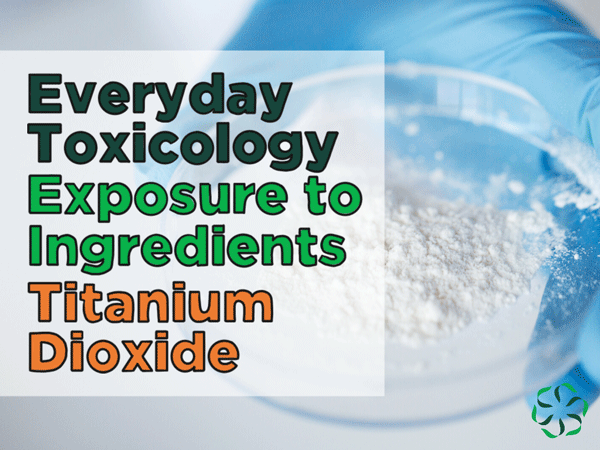In prior posts, we’ve discussed the many routes we’re exposed to ingredients. In this post, we take a deeper look at the ingredient titanium dioxide to explore how exposure routes impact research and health outcomes.
What is titanium dioxide?
Titanium is a common metal element frequently found throughout nature. In our environment, titanium is naturally exposed to oxygen, forming titanium oxides that we find in many minerals, dusts, sands, and soils.
Titanium dioxide is one of the many oxides formed naturally in our environment. Manufacturers source this mined-mineral from rutile, brookite, and anatase. It is then processed and refined to meet stringent safety guidelines based on the end-use for the mineral.
Titanium dioxide is an insoluble mineral, meaning it cannot dissolve in water. Known for its bright, white pigment, manufacturers use titanium dioxide in many different capacities, including in cosmetics, foods, and drugs.
When manufacturers add titanium dioxide to foods and other ingestible products, it’s typically referred to as E171, as this relates to food-grade purity.
What does titanium dioxide do?
Titanium dioxide can amplify and brighten white opacity because of its exceptional light-scattering properties. In food and drugs, these properties help to define colors clearly and can prevent products from UV degradation.
In cosmetics, titanium dioxide’s properties enhance coloration and can help protect skin from damaging UVA and UVB rays.
What is an exposure route?
Exposure routes are the pathways that allow ingredients to enter our bodies. Primary exposure routes include:
- our digestive tract through eating and drinking.
- topically via our skin.
- through our respiratory tract by breathing.
- occasionally, through our blood and eyes.
How are we typically exposed to titanium dioxide?
There are many ways we’re exposed to titanium dioxide in our everyday life. Below are the most common ways we come into contact with titanium dioxide.
Digestive System Exposure
We’re most often exposed to E171 through the foods we ingest. We find E171 in many food products, like popsicles, ice cream, gum, and more. Another way we ingest E171 is through pharmaceutical drugs. Many pills and capsules contain E171 as an inactive ingredient.
Less frequently, we ingest E171 through liquids such as salad dressing, dairy products, and some artificially colored drinks. However, since E171 is insoluble, manufacturers must use other stabilizers to keep E171 suspended in liquids as an emulsion; otherwise, it will settle to the bottom.
Topical Exposure
We apply titanium dioxide to our skin in the form of sunscreens, makeup, lip balms, nail polish, and other cosmetic products.
We even use titanium dioxide when brushing our teeth as it’s found in many toothpastes.
Respiratory Exposure
In industrial settings, people can be exposed to titanium dioxide through inhalation. Inhalation exposure to titanium dioxide is exceedingly rare for most people.
Why does the exposure route matter and does titanium dioxide harm our health?
How we’re exposed to an ingredient matters greatly in terms of our long-term health.
Research shows that inhaling titanium dioxide particles in significant quantities over time can cause adverse health outcomes. Unless you work in an industrial setting, inhaling substantial amounts of titanium dioxide is highly unlikely.
Research supports that applying titanium dioxide to the skin in the form of sunscreens, makeup, and other topical products does not pose any health risks.
Overwhelmingly, research that’s relevant to human’s eating patterns shows us that E171 is safe when ingested normally through foods and drugs (1,2,3).
Other research suggests that E171 could cause harm; however, those research processes did not take into consideration how people are typically exposed to E171. Research that adds E171 to drinking water, utilizes direct injections, or gives research animals E171 through a feeding apparatus is not replicating typical human exposure.
Let’s break this down further.
In food products, E171 is not a singular ingredient; it’s always combined with other ingredients (e.g., proteins and fats) in the food product. Digesting food is a slow process for the body compared to drinking a beverage, which passes much more quickly through the body (1,2).
When E171 is part of a food product, it passes through the digestive system without causing harm because E171 combines with the other ingredients.
In some studies, E171 was given to animals in drinking water without the stabilizers that keep E171 suspended in the liquid. Without stabilizers, E171 can settle and prevent the ingredient from combining with surrounding ingredients. When E171 isn’t combined with other ingredients, it can drastically alter the way it’s processed in the body, which could produce adverse health impacts.
However, humans are not exposed to E171 in drinking water at any significant quantity over a long duration, so this potential effect is not relevant to the human experience. It’s important to understand that a potential hazard is not the same thing as an actual risk.
The good news.
As we’ve discussed in previous posts, a hazard is not a risk. Knowing that something could cause harm in a specific situation that we’re unlikely to experience can help us make sound decisions.
Understanding the real risk verse the theoretical risk helps us to understand how emerging research can be applied to our daily lives.

